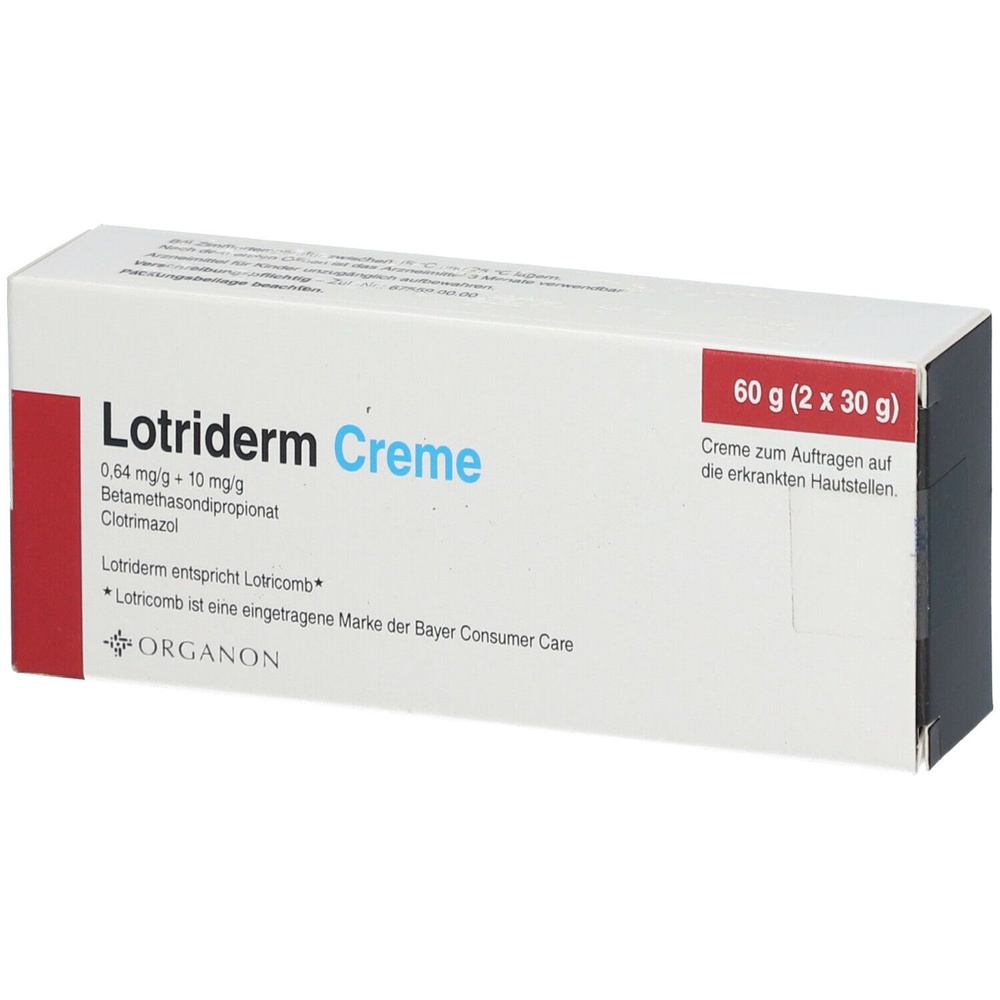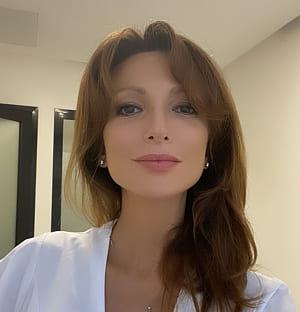

Lotriderm

Ask a doctor about a prescription for Lotriderm

How to use Lotriderm
Package Leaflet: Information for the User
Lotriderm, (0.64 mg + 10 mg)/g, Cream
Betamethasone dipropionate+ Clotrimazole
Read the package leaflet carefully before using the medicine, as it contains important information for the patient.
- Keep this package leaflet, you may need to read it again.
- If you have any further questions, ask your doctor or pharmacist.
- This medicine has been prescribed for you only. Do not pass it on to others. It may harm them, even if their symptoms are the same as yours.
- If you experience any side effects, including any not listed in this leaflet, please tell your doctor or pharmacist. See section 4.
Contents of the Package Leaflet
- 1. What is Lotriderm and what is it used for
- 2. Important information before using Lotriderm
- 3. How to use Lotriderm
- 4. Possible side effects
- 5. How to store Lotriderm
- 6. Contents of the pack and other information
1. What is Lotriderm and what is it used for
Lotriderm is a cream for topical use on the skin. The active substances are betamethasone dipropionate and clotrimazole.
Betamethasone dipropionate belongs to a group of strong corticosteroids. When applied topically, it has anti-inflammatory, antipruritic, and vasoconstrictive effects.
Clotrimazole belongs to a group of imidazole derivatives with topical antifungal activity.
Indications
Lotriderm cream is indicated for the treatment of fungal infections of the groin, perineal area, feet, and non-hairy skin caused by fungi Trichophyton rubrum, Trichophyton mentagrophytes, Epidermophyton floccosum, and Microsporum canis, as well as candidiasis caused by Candida albicanswith accompanying inflammatory or allergic reactions.
2. Important information before using Lotriderm
When not to use Lotriderm:
- if you are allergic to betamethasone dipropionate, clotrimazole, or other corticosteroids, imidazole derivatives, or any of the other ingredients of this medicine (listed in section 6).
Warnings and precautions
Before starting treatment with Lotriderm, discuss it with your doctor or pharmacist.
Lotriderm should not be used under occlusive dressings or diapers.
If you experience any allergic reactions or irritation, discontinue use of Lotriderm and consult your doctor.
In case of bacterial infection, your doctor will prescribe appropriate antibacterial treatment.
Betamethasone dipropionate, like other corticosteroids, is absorbed through the skin. Therefore, during treatment with Lotriderm, general side effects of betamethasone dipropionate characteristic of corticosteroids may occur, including adrenal suppression, Cushing's syndrome, increased blood sugar levels, and glucose in the urine.
The absorption of corticosteroids into the body after topical application increases with prolonged treatment time or when applied to large areas of the body.
Avoid using Lotriderm on large areas of skin, damaged skin, in large doses, or for prolonged treatment.
Due to the content of a strong corticosteroid (betamethasone dipropionate), patients using the medicine on large areas of the body should be periodically examined to exclude adrenal suppression. If symptoms of adrenal suppression occur, your doctor will decide whether to discontinue treatment with Lotriderm or reduce the dose of the medicine, or use a medicine containing a corticosteroid with weaker action.
Lotriderm should not be used in ophthalmology.
If you experience blurred vision or other vision disturbances, consult your doctor.
Children and adolescents
Children may be more sensitive to the suppression of the hypothalamic-pituitary-adrenal axis after topical application of corticosteroids due to greater absorption of the corticosteroid into the body compared to adults, resulting from a larger skin surface area to body mass ratio.
In children treated with topical corticosteroids, there have been reports of suppression of the hypothalamic-pituitary-adrenal axis, Cushing's syndrome, growth retardation, weight gain retardation, and increased intracranial pressure.
Symptoms of adrenal insufficiency include low cortisol levels in the blood and lack of response to ACTH stimulation. Symptoms of increased intracranial pressure include: bulging fontanelle, headaches, and bilateral optic disc edema.
Lotriderm and other medicines
Tell your doctor or pharmacist about all medicines you are taking, have recently taken, or might take.
No interactions with other medicines are known.
Pregnancy and breastfeeding
If you are pregnant or breastfeeding, think you may be pregnant, or are planning to have a baby, ask your doctor or pharmacist for advice before using this medicine.
Pregnancy
The medicine can be used during pregnancy only if the doctor considers that the benefit to the mother outweighs the risk to the mother, fetus, or newborn. The medicine should not be used in large quantities or for an extended period in pregnant women.
Breastfeeding
The doctor will decide whether to discontinue breastfeeding or use the medicine, considering the importance of the medicine to the mother.
When using the medicine during breastfeeding, be careful not to let the medicine come into contact with the breast skin, as this may cause accidental ingestion of the medicine by the infant or accidental contact of the medicine with the infant's skin.
Driving and using machines
No data are available on the effect of Lotriderm on the ability to drive or use machines.
Lotriderm cream contains cetostearyl alcohol, propylene glycol, and benzyl alcohol.
Due to the presence of cetostearyl alcohol, the medicine may cause local skin reactions (e.g., contact dermatitis).
The medicine contains 100 mg of propylene glycol in each gram of cream. Propylene glycol may cause skin irritation. Due to the presence of propylene glycol, the medicine should not be used on open wounds or large areas of damaged or broken skin (e.g., burned skin) without consulting a doctor or pharmacist.
The medicine contains 10 mg of benzyl alcohol in each gram of cream. Benzyl alcohol may cause allergic reactions or mild local irritation.
3. How to use Lotriderm
Always use this medicine exactly as your doctor has told you. If you are not sure, ask your doctor or pharmacist.
Adults and children over 12 years
A thin layer of Lotriderm should be applied to the affected areas of skin and surrounding skin, usually twice a day: in the morning and evening.
The treatment duration is:
- 2 weeks for fungal infections of the groin, perineal area, and non-hairy skin, as well as candidiasis,
- 4 weeks for fungal infections of the feet.
Improvement, manifested by the disappearance of redness and itching, usually occurs within the first 3 to 5 days of treatment.
If, in the case of treatment of fungal infections of the groin, perineal area, and non-hairy skin, as well as candidiasis, improvement does not occur within a week, and in the case of fungal infections of the feet within two weeks of treatment, consult your doctor, as verification of the diagnosis is necessary.
If, in the case of treatment of fungal infections of the groin, perineal area, and non-hairy skin, as well as candidiasis, symptoms of the disease persist after two weeks of treatment, and in the case of fungal infections of the feet after four weeks, consult your doctor. Your doctor will decide whether to discontinue treatment with Lotriderm and use other treatment.
It is not recommended to use Lotriderm for more than 4 weeks.
Use in children and adolescents
Lotriderm is not recommended for use in children under 12 years of age.
Using more than the recommended dose of Lotriderm
If you use more than the recommended dose, seek medical attention immediately.
Extensive, prolonged topical use of corticosteroids may lead to suppression of the hypothalamic-pituitary-adrenal axis and the occurrence of systemic side effects characteristic of corticosteroids (see section 2).
If symptoms of adrenal suppression occur, your doctor will decide whether to discontinue treatment with Lotriderm or reduce the dose of the medicine, or use a medicine containing a corticosteroid with weaker action.
Missing a dose of Lotriderm
Do not take a double dose to make up for a forgotten dose.
If you have any further questions on the use of this medicine, ask your doctor or pharmacist.
4. Possible side effects
Like all medicines, Lotriderm can cause side effects, although not everybody gets them.
After application of the medicine, the following side effects occur rarely (in less than 1 in 1000 patients):
altered sensation, burning sensation, papular rash, edema, urticaria, and secondary infections.
After application of the medicine, due to the presence of clotrimazole, the following side effects may occur: redness, burning sensation, blistering, edema, itching, urticaria, and general skin irritation.
After application of the medicine, due to the presence of betamethasone dipropionate, the following side effects may occur: burning sensation, itching, irritation, dryness of the skin, folliculitis, hypertrichosis, acneiform rash, skin depigmentation, perioral dermatitis, allergic contact dermatitis, skin maceration, secondary infections, skin atrophy, striae, petechiae, and hypersensitivity.
During treatment with corticosteroids, blurred vision (frequency not known) has been observed.
Reporting side effects
If you experience any side effects, including any not listed in this leaflet, please tell your doctor or pharmacist. Side effects can be reported directly to the Department of Drug Safety Monitoring of the Office for Registration of Medicinal Products, Medical Devices, and Biocidal Products:
Aleje Jerozolimskie 181C, 02-222 Warsaw, Tel.: + 48 22 49 21 301, Fax: + 48 22 49 21 309,
Website: https://smz.ezdrowie.gov.pl .
Side effects can also be reported to the marketing authorization holder.
Reporting side effects will help to gather more information on the safety of this medicine.
5. How to store Lotriderm
Keep this medicine out of the sight and reach of children.
Store in a temperature below 25°C. Store in the original package.
Do not use this medicine after the expiry date stated on the carton and aluminum tube after:
“EXP”. The expiry date refers to the last day of the month.
Medicines should not be disposed of via wastewater or household waste. Ask your pharmacist how to dispose of medicines no longer required. This will help protect the environment.
6. Contents of the pack and other information
What Lotriderm contains
- The active substances are betamethasone dipropionate and clotrimazole. Each gram of cream contains 0.64 mg of betamethasone dipropionate and 10 mg of clotrimazole.
- The other ingredients are: liquid paraffin, white petrolatum, cetostearyl alcohol, propylene glycol, cetomacrogol 1000, benzyl alcohol, sodium dihydrogen phosphate dihydrate, phosphoric acid concentrated, sodium hydroxide (for pH adjustment), diluted phosphoric acid (for pH adjustment), purified water.
What Lotriderm looks like and contents of the pack
Lotriderm is a cream.
Packaging of the medicine:
An aluminum tube with a polyethylene cap, containing 15 g of cream, placed in a cardboard box.
Marketing authorization holder and manufacturer
Marketing authorization holder:
Organon Polska Sp. z o.o.
Marszałkowska 126/134 Street
00-008 Warsaw
Tel.: + 48 22 105 50 01
[email protected]
Manufacturer:
Organon Heist bv
Industriepark 30
2220 Heist-op-den-Berg
Belgium
Date of last revision of the leaflet: 11/2022
- Country of registration
- Active substance
- Prescription requiredYes
- Manufacturer
- ImporterOrganon Heist bv
- This information is for reference only and does not constitute medical advice. Always consult a licensed doctor before taking any medication. Oladoctor is not responsible for medical decisions based on this content.
- Alternatives to LotridermDosage form: Ointment, (1.22 mg + 30 mg)/gActive substance: betamethasone and antisepticsPrescription requiredDosage form: Cream, (1.22 mg + 30 mg)/gActive substance: betamethasone and antisepticsPrescription requiredDosage form: Ointment, (30 mg + 10 mg)/gActive substance: hydrocortisone and antisepticsManufacturer: Chema-Elektromet Spółdzielnia PracyPrescription required
Alternatives to Lotriderm in other countries
The best alternatives with the same active ingredient and therapeutic effect.
Alternative to Lotriderm in Ukraine
Online doctors for Lotriderm
Discuss dosage, side effects, interactions, contraindications, and prescription renewal for Lotriderm – subject to medical assessment and local rules.







